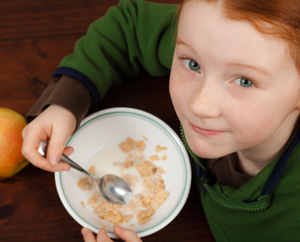Penn Herb Wellness Guide
Surprise! Kids Like Low-Sugar Cereals Just Fine

Breakfast, at what cost?
Breakfast, which literally means “breaking the fast” since the last night’s meal, is arguably the most important meal of the day. Children who eat breakfast regularly tend to fare better in school and have better overall nutrition and lower BMI (body mass index, a measure of body leanness or overweight) than those who skip out on the meal.
Ready-to-eat cereals are a quick and easy way to manage the breakfast rush, but there’s debate about whether the benefits of feeding children highly sweetened cereals outweighs the drawbacks. Those who support eating any kind of ready-to-eat cereal (sugary or not), contend that cereal is only part of the meal: that children are also getting milk and possibly fruit. They also argue that the added sugar just makes it taste better, so children will actually eat breakfast and still benefit fromvitamins and minerals in these cereals that might otherwise be missed.
To find out more about children’s cereal preferences and the amount of sugar, fruit, and milk they eat with breakfast, researchers from Yale University provided 91 children ages 5 to 12 years old with a choice of three low-sugar or high-sugar cereals for breakfast. Low-sugar options included Cheerios, Rice Krispies, and Corn Flakes; high-sugar choices were Froot Loops, Cocoa Pebbles, and Frosted Flakes. The children were also given an 8 ounce carton of milk, a small container of orange juice, and bowls of precut strawberries and bananas. Sugar packets, extra juice, and milk were available.
If you serve it, they will eat it
Children in both groups ate the cereal they were offered, and both groups reported that they “liked” or “loved” the cereal they chose. Children in the low-sugar group ate, on average, one serving of cereal, whereas children in the high-sugar group ate about two servings. While children in the low-sugar group added more table sugar to their cereal, children in the high-sugar group ate almost twice as much refined sugar as those in the low-sugar group. Children in the low-sugar group also added more fruit to their cereal. Both groups used the same amount of milk.
“These results indicate that high-sugar cereals likely promote larger portion sizes,” said lead author of the study, Jennifer Harris, PhD, of the Rudd Center for Food Policy and Obesity at Yale University. “Children in the low-sugar group consumed more of their calories from fresh fruit, whereas sugar comprised a larger proportion of calories in the high sugar group. As a result, the overall nutritional quality of the low sugar cereals was superior.”
So, the takeaway? Try serving low-sugar cereals with fruit toppings to your family for breakfast and either phase out high-sugar varieties completely, or make them a dessert or special treat—not everyday eating.
(Pediatrics 2010;doi:10.1542/peds.2010-0864)
Kimberly Beauchamp, ND, received her doctoral degree from Bastyr University, the nation’s premier academic institution for science-based natural medicine. She co-founded South County Naturopaths in Wakefield, RI, where she practiced whole family care with an emphasis on nutritional counseling, herbal medicine, detoxification, and food allergy identification and treatment. Her blog, Eat Happy, helps take the drama out of healthy eating with real food recipes and nutrition news that you can use. Dr. Beauchamp is a regular contributor to TraceGains Newswire.
Copyright 2025 TraceGains, Inc. All rights reserved.


